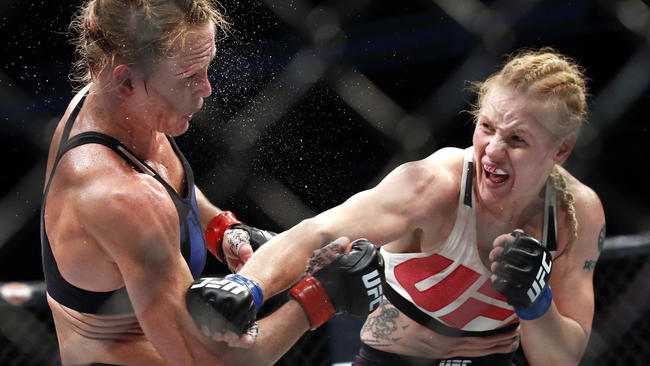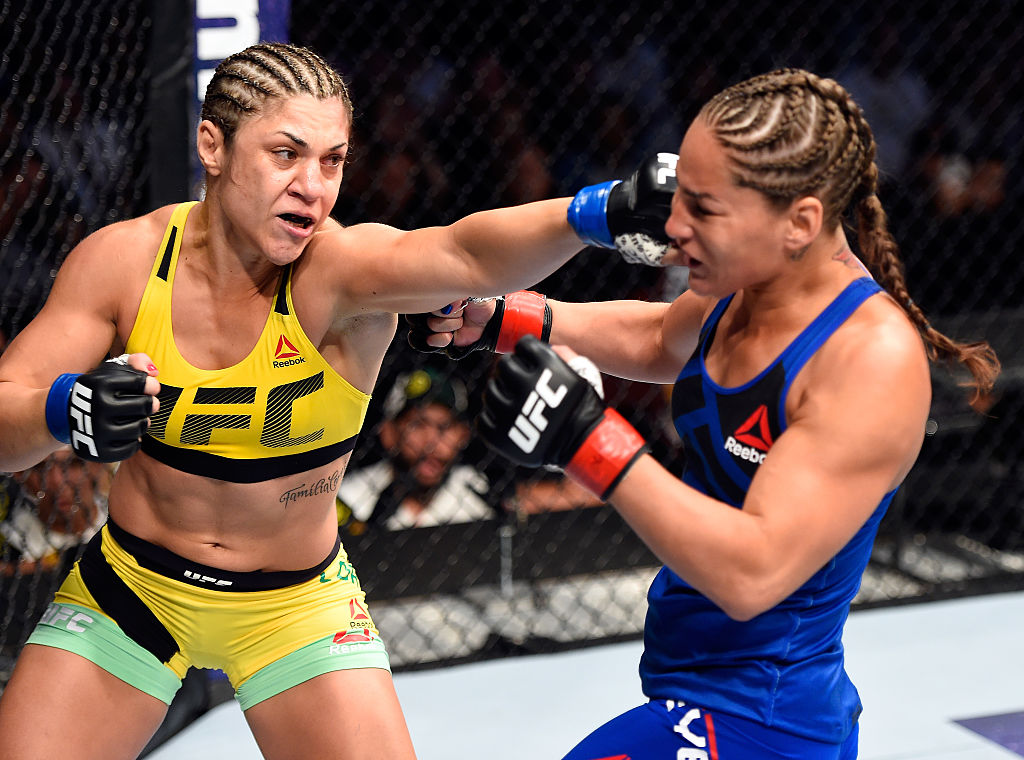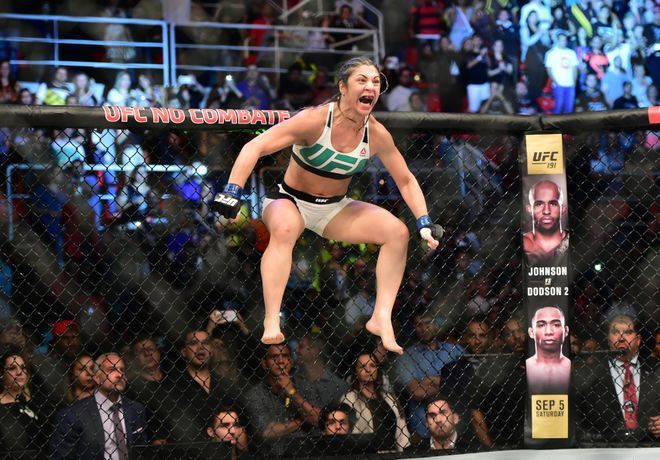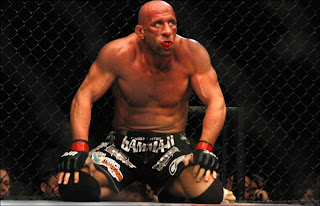Saturday in Singapore at UFC Fight Night 111, Holly Holm and Bethe Correia meet in the Octagon in the most important fight in either fighter’s career. The former UFC Women’s Bantamweight Champion Holm has been on a losing streak since reaching a career peak with a one-sided stoppage win over former bantamweight queen and pound-for-pound entrant Ronda Rousey. Correia was at one point undefeated in the Ultimate Fighting Championship, rising up the ranks and challenging for a world title before being summarily dismissed in one round by the aforementioned Rousey. Since then Correia’s skills have continued to improve, but the results of her fights haven’t been nearly as fruitful.
Today we give you ten talking points that explain why this fight is being made, as well as offer a closer look at the two participants’ strengths, weaknesses, and the finer points of their games, so that you have the information that will assist your understanding and enjoyment of this very important and career-defining fight:
10) Holly Holm’s entire (successful) career has been filled with favorable matchups. Before and after joining the UFC she was matched with fighters who had clear limitations in experience, athleticism, or some specific technical aspect of their game. That essentially masked the obvious holes in her game on the feet and even more obvious holes in every other phase of mixed martial arts. Once the level of athleticism, experience, skills, and refinement in key areas increased in her opponents, Holm started losing decisively. Germaine de Randamie, Miesha Tate, and Valentina Shevchenko were the most experienced, physically gifted, skillful opponents she faced, fighters with defined identities who didn’t play to her strengths and whose styles/skills clearly exploited the weaknesses in her game. The best fighters can win bad matchups; Holm has not done so, not even once.
9) Holly Holm’s biggest advantages over Bethe Correia are all attribute based: Holly is bigger, longer, quicker-footed, quicker-fisted, more explosive, and more flexible; not to mention her ability to fight at a faster, harder pace than most fighters. But while Holm is a better striker overall, if Correia had the same skillset with Holm’s athleticism, she would outclass Holm on the feet. A lot of Holm’s style and success with it are firmly rooted in her physicality and athleticism; this allows her to be mobile, super busy with her volume, effective with her kicks, and effective in spite of limitations in stance and creativity. I am not saying she isn’t skilled or tenured — she is — but I can’t ignore how much of a weapon her physical tools are.
8) Bethe Correia has actually shown the better all-round skills in the cage. People often comment that Holm is a better caliber of fighter; within the context of boxing and kickboxing, maybe. But within the context of mixed martial arts, I don’t think that is true. Correia is better and more successful with takedowns, most of them being (in/out) trips from the clinch; she also has better offensive footwork, good enough to pressure opponents and draw attacks to counter. Correia has also shown better submission defense. Want proof? Correia lasted almost a whole round on the ground with a world champion without being submitted (even after being rocked with a head kick). Compare that to Holm, who was finished by Tate with thirty seconds left in a title fight she was clearly in control of. Outside of that, Correia is the more organic striker in regards to the shots selected and placed in her combinations. Correia has also shown an ability to adjust, which Holm hasn’t, and she has the superior cage IQ in transitioning from range to range, as well as picking the right tools for an in-fight situation, or for a specific opponent.
7) Holly Holm is a multiple time world champion in boxing, but Holm, for as good as she was, was not a technician. Her wins were a result of volume, activity, and pace; they were not a result of accuracy, excellent punching mechanics, or efficient offensive footwork. And if you look at her time in mixed martial arts, you gets even more evidence of that being true. She is a “world class” boxer whose best and most damaging weapons are her kicks. Let that sink in.
6) Bethe Correia is a “right idea, wrong execution” type fighter; because of her limited experience as a fighter and as a person training in martial arts, her ability to execute on the feet and the ground aren’t textbook. There are few fighters whose techniques aren’t better than Correia’s; on the flipside, there are very few fighters who have a better sense of when and where to use a technique. I.e., her cage IQ is elite; her ability to execute is not.
5) Both women fought Ronda Rousey (I know you know that), and both women had the same general game plan. They both wanted to exploit Rousey’s confidence on the feet, let her bull rush in an attempt to land punches (to do harm or set up the clinch), and use deft defensive footwork to provide opportunities to counter her.
 4) Correia and Holm are both most effective on the counter. Holm’s sense of range and ability to maintain or extend her range allows her to manipulate her opposition’s footwork, activity, and pressure, creating opportunities to score by moving around and forcing opponents to pursue. Holm’s length, athleticism, and defensive footwork allows her to out-position opponents and extend the distance, forcing them to try to close the distance or cut the cage down. This allows Holm to pick them off with a variety of jabs, straight shots, and kicks, which are made more impactful due to the collision created by Holm’s offense coming out and the opponent coming in, a strategy somewhat similar to that of Lyoto Machida or Gunnar Nelson. The difference between Holm and these two, however, is her willingness to lead and the amount of volume she throws.
4) Correia and Holm are both most effective on the counter. Holm’s sense of range and ability to maintain or extend her range allows her to manipulate her opposition’s footwork, activity, and pressure, creating opportunities to score by moving around and forcing opponents to pursue. Holm’s length, athleticism, and defensive footwork allows her to out-position opponents and extend the distance, forcing them to try to close the distance or cut the cage down. This allows Holm to pick them off with a variety of jabs, straight shots, and kicks, which are made more impactful due to the collision created by Holm’s offense coming out and the opponent coming in, a strategy somewhat similar to that of Lyoto Machida or Gunnar Nelson. The difference between Holm and these two, however, is her willingness to lead and the amount of volume she throws.
On the other hand, Correia, whose athleticism isn’t a tenth of Holm’s, relies on timing and pressure, much like Daniel Kelly, in that her game isn’t defined by top end athleticism or high-level technical skill. She is defined by grit, deliberate aggression, physicality, and volume. She applies pressure to opponents, forcing them to attack under the perceived threat that comes with her pressure and feints. Once an opponent attacks, Correia is in her comfort zone; she takes advantage of openings presented to her by opponents trying to push her back or halt her forward movement with sharp and well-timed counters. Unlike many counter fighters who will hit you with ones and twos, Correia will swarm with threes, fours, fives, and sixes, attacking the head and body and forcing her opponent back, punching her way into clinches, then breaking down her rivals with short punches, elbows, and knees.
3) Neither Correia nor Holm is effective initiating offense, but they each are lacking in this area for different reasons. Correia’s inability to initiate offense is a side effect of her below average athleticism, as she lacks the foot speed and hand speed that can mask the lack of refinement and depth in her offensive footwork and tools (i.e. jab, feints). Correia’s IQ is very high, but her physical IQ isn’t, and the combination of limited athleticism and limited technical development (based on time invested) hurts her.
In Holm’s case, her issue is a matter of stance and temperament. Her stance forces her to cover excessively long distances, which allows her opponent more time to react and more opportunity to figure out her pattern and timing. Another issue is that Holm is very predictable in her setups, her techniques, and the manner she structures her offensive bursts and combinations; on top of the “shaky” punching mechanics, any attempt for Holm to lead often ends with her being countered.
2) This fight is a showcase for Holly Holm, as the UFC likes her and has invested a lot of money and effort into her; the promotion wants to see her succeed and has routinely put her in the position to get back to the bantamweight title, as well as pick up a featherweight championship. Now the matchmakers are trying to get her back on the winning track by having her fight a “beatable” opponent who has enough cachet to draw attention and enough skill and cage IQ to make the win legitimate.
1) Bethe Correia didn’t get this fight because she is considered elite, even though her ranking says she is; she got this fight because of her mouth, her character. As underrated as her skills are, she still hasn’t beaten a top end athlete or an elite fighter, but she has managed to get more publicity and notoriety than much much more successful fighters. Correia knows how to sell herself, knows how to play to crowds, and knows how to drum up interest in fights that for all intents and purposes don’t have a big impact on divisional rankings. Her mouth has gotten her more fights and made her more money than her skills. On the downside, her over the top character and comments (as well as her dance moves) have resulted in people overlooking her ever-improving skills and elite cage IQ.
At UFC Fight Night Singapore we will see either the rebirth of Holly Holm or the reinvention of Bethe Correia. Both are very good fighters who haven’t reached the potential that early wins had hinted they would reach. Nonetheless, it’s an important fight for the division and for the individual fighters themselves. I hope this article has given you some things to look for, both in your analysis of the fight before it and for your enjoyment during it.
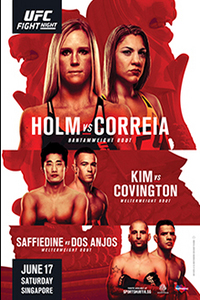
UFC Fight Night 111: Holm vs. Correia takes place June 17, 2017 at Singapore Indoor Stadium in Kallang, Singapore.
Click the stars to rate how good you think UFC Fight Night 111 will be.
*********


